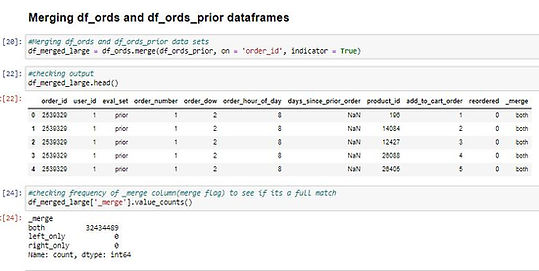

Instacart Grocery Basket Analysis
Project Overview:
Instacart, an online grocery store that operates through an app wants to uncover more information about their sales patterns. The stakeholders are most interested in customers profiles and purchasing behaviors
Objective:
The company aims to understand customer profiles and behaviors to enhance its marketing campaigns. By conducting an exploratory analysis of their data, new insights can be uncovered and utilized to develop effective strategies.
Tools:
Python including Pandas, NumPy, MatPlotLib, Seaborn, SciPy libraries
My Role:
In this project, I functioned as a business intelligence analyst. I managed the data throughout the entire process, delivering both business insights and the final report.

Data Overview
Data Set:
The Instacart Online Grocery Shopping
Dataset 2017
Accessed from Kaggle
Skills and Techniques:
Data wrangling
Data merging
Deriving variables
Grouping data
Aggregating data
Reporting in Excel
Population flows
Key Business Questions:
Busiest days of the week and hours of the day
Particular times of the day when people spend the most money
Simpler price range groupings
Products that are more popular than others
Departments with high frequency of orders
Different types of customers and their ordering behaviors
Data Prep and Exploration
Data Profiling:
Performed exploratory descriptive analysis to comprehend data set dimensions, fields, data types, sources, and identify key variables.
Additionally, merged department, order, product, and customer datasets to facilitate more in-depth analysis.
Data Wrangling:
Adjusted data types of variables and renamed columns
Corrected mixed-type variables
Handled missing values and duplicate data rows
Filtered out low-value customers by creating an exclusion flag for those with fewer than five orders, as they spent minimally on Instacart and are thus not relevant for enhancing marketing strategies.
Deriving New Variables:
Generated new dataframe subsets to categorize products by price range and identify the busiest and least busy days of the week based on count of orders to support analysis
Derived new variables
Established flags to begin categorizing customer behavior
Created summary columns containing descriptive statistics
Merging dataset

Created a new column using loc [ ] function
![instacart using loc [ ] cropped.JPG](https://static.wixstatic.com/media/d294fe_e4d240b7f556498b97acb99dc892a1b2~mv2.jpg/v1/fill/w_596,h_228,al_c,q_80,usm_0.66_1.00_0.01,enc_avif,quality_auto/instacart%20using%20loc%20%5B%20%5D%20cropped_JPG.jpg)




Analysis and Insights
Key business Questions and Insights gained
1. Busiest days of the week and hours of the day
Saturday and Sunday
9am to 4pm
2. Particular times of the day when people spend the most money
People spend the same amount of money throughout the day, except between 3 AM to 5 AM when a dip in money spent in noticed
3. Simpler price range groupings
We have categorized products based on prize into 3 categories: i)Low-range, ii) MId-range, iii)High-range
4. Products that are more popular than others
Produce, Dairy/Eggs, and Snacks departments have demonstrated higher frequency of product orders, indicating stronger customer interest.
5. Different types of customers and their ordering behaviors
Distribution among users on their brand loyalty on Instacart: Regular Customers: 49%, Loyal Customers: 31.7%, New Customers: 19.3%
Loyal customers place the orders during weekends (Saturday and Sunday)
Peak ordering hours for loyal customers occur between 10:00 AM to 4:00 PM
Loyal customers show a preference for medium-range products
Final Recommendations
Product Highlighting: Showcase advertisements during the least busy days and hours which can help drive sales for products that may otherwise be overlooked during busier periods.
Targeted Promotions and Offers: Offer exclusive discounts or bundle deals during off-peak times to attract customers who may be less inclined to shop during busier periods.
Advertise High-priced Products During Peak Spending Hours: During the peak spending hours of the day Instacart should advertise high-priced products to capitalize on customers' willingness to spend.
Pricing Strategies: during peak spending hours, prices for high-demand products could be slightly increased to gain additional revenue.
The marketing and sales team can focus their efforts on promoting mid-range and low-range products, as they collectively make up a significant portion of sales.
Customer Retention Strategies: Focus on retaining regular and loyal customers by implementing customer loyalty programs, personalized offers, and rewards for repeat purchases
Onboarding and Engagement for New Customers: Develop targeted onboarding processes and engagement strategies for new customers to enhance their initial experience with Instacart
Feedback Mechanisms: Implement feedback mechanisms to gather insights from customers at different stages of their journey, including new, regular, and loyal customers.
Product Assortment Optimization: Ensure that there is a wide selection of medium-range products available on the platform. Conversely, consider strategies to boost the visibility and appeal of low-range products to increase their uptake among loyal customers.
